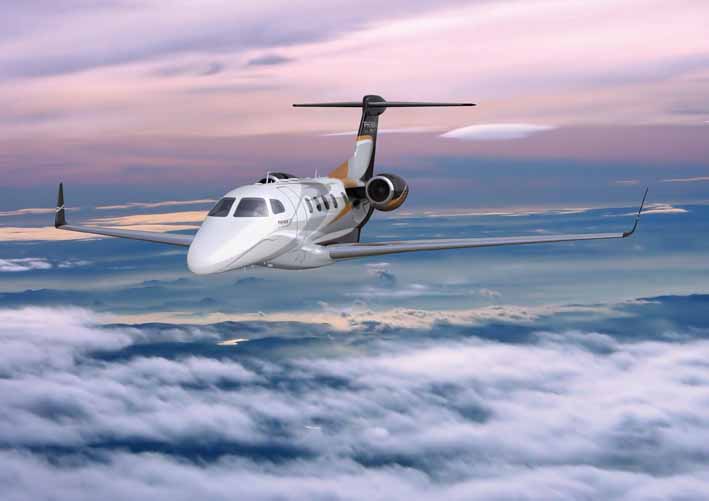
News
Phenom 300 on target
 NEWS HIGHLIGHT
NEWS HIGHLIGHT
Phenom 300 on target
With the first flight of
the fifth Phenom 300 aircraft on Aug. 8,
Embraer’s light jet program achieved an important milestone toward
certification.
August 18, 2009 By Carey Fredericks

|
|
|
|
Aug. 18, 209, São José dos Campos, Brazil – With the first flight of the fifth Phenom 300 aircraft, tail number PP-XVM, on August 8, Embraer’s light jet program achieved an important milestone toward certification. This aircraft, the first with a completed interior was exhibited at the Latin American Business Aviation Conference and Exhibition (LABACE), August 13-15, at Congonhas Airport, in the city of São Paulo, Brazil.
The airplane will now be used for function and reliability tests and the maturity campaign, when important functions and features such as its single point refueling, externally serviced lavatory (unique in the category) and low cabin altitude.
“The current fleet of four prototypes has accumulated over 850 test flight hours,” said Maurício Almeida, Embraer Vice President, Programs – Executive Jets. “With this fifth aircraft, we will validate the robustness of the Phenom 300 under normal operating conditions and the superior comfort of its interior, which was designed in partnership with BMW Group DesignworksUSA.”
The first prototype (PP-XVI) has been used for flight quality and performance evaluation. To the present time, the aircraft has performed ground vibration, anti-icing system and undrainable fuel tests, as well as stall, crosswind takeoff and landing, flutter and high-speed tests. The airplane was also used for the aerodynamic configuration finalization. The anti-icing system was verified under natural ice conditions and the airframe is currently being evaluated under simulated icing conditions.
The second prototype (PP-XVJ) performed water spray and engine fire detection tests. It was also used for the expansion of the Vmo (maximum operating limit speed) envelope and testing external noise and engine controllability, engine fire extinguishing, in-flight start, fuel system, external lighting, and autopilot – which is in the final test stages. The aircraft is now in Bolivia, performing high-altitude takeoff tests. The airplane was also used to collect data for the full flight simulator, which will be certified for pilot training.
The third prototype (PP-XVK) has completed flight control tests and is currently performing all tests necessary for determining takeoff and landing performance, including the evaluation of minimum control speeds in the air and on the ground.
The fourth prototype (PP-XVL) successfully completed HIRF (High Intensity Radiated Field), lightning, cold soak, and external noise tests. The airplane was also used to validate the maintenance plan and is now dedicated to internal noise tests, among others. Besides the four aircraft in the flight test campaign, Embraer is presently performing ground- based structural tests with dedicated test specimens. Equipped with swept wings and high performance winglets, the Phenom 300 indicated it is on the way to accomplish its design goals, cruising at 833 km per hour, or 450 knots (KTAS), and flying 3,334 km (1,800 nautical miles), with six occupants and NBAA IFR reserves.
The certification campaign of the Phenom 300 should be concluded during the last quarter of 2009, with the first deliveries being made by the end of the year. The Phenom 100 and Phenom 300 executive jets, together, have logged more than 800 firm orders, worldwide.
About the Phenom 300 jet
The Phenom 300 light jet accommodates up to ten occupants in a spacious and pleasant interior, also designed in partnership with BMW Group DesignworksUSA. Swept wings, with winglets, and modern onboard systems were developed with outstanding flight performance in mind. A single refueling port, an externally serviced lavatory, and excellent cabin pressurization are some of the jet’s distinctive features. The Phenom 300 is one of the fastest aircraft in the light jet category, reaching 518 mph (833 km/h, or 450 knots – KTAS), and it can fly at an altitude of up to 45,000 feet (13,716 meters). Its range of 1,800 nautical miles (3,334 km), including NBAA IFR fuel reserves, means the aircraft is capable of flying nonstop from New York to Dallas, in the U.S.; from London to Athens, in Europe; or from Delhi (India) to Dubai (United Arab Emirates). In order to meet the demands of executive jet customers, Embraer invested in the creation of a support system consisting of six Company-owned service centers and an extensive authorized service center network, worldwide. The Company also has partnerships with renowned companies in the areas of logistics and pilot and mechanic training, besides offering routine inspections, scheduled and unscheduled maintenance and special service solution programs, like the Embraer Executive Care (EEC). The Company’s product support structure covers flight operations, and technical and maintenance support customized according to the operating profile of each aircraft, as well as a new customer Contact Center. This structure makes possible a significant reduction of the aircraft costs and downtime and maximizes the benefits of this important business tool. More information about Embraer Executive Jets is available at www.EmbraerExecutiveJets.com .